
An illuminated manuscript is a formally prepared document where the text is often supplemented with flourishes such as borders and miniature illustrations. Often used in the Roman Catholic Church for prayers, liturgical services and psalms, the practice continued into secular texts from the 13th century onward and typically include proclamations, enrolled bills, laws, charters, inventories and deeds.

The book of hours is a Christian devotional book used to pray the canonical hours. The use of a book of hours was especially popular in the Middle Ages and as a result, they are the most common type of surviving medieval illuminated manuscript. Like every manuscript, each manuscript book of hours is unique in one way or another, but most contain a similar collection of texts, prayers and psalms, often with appropriate decorations, for Christian devotion. Illumination or decoration is minimal in many examples, often restricted to decorated capital letters at the start of psalms and other prayers, but books made for wealthy patrons may be extremely lavish, with full-page miniatures. These illustrations would combine picturesque scenes of country life with sacred images. Books of hours were usually written in Latin, although there are many entirely or partially written in vernacular European languages, especially Dutch. The closely related primer is occasionally considered synonymous with books of hours, but their contents and purposes could deviate significantly from simply recitation of the canonical hours. Tens of thousands of books of hours have survived to the present day, in libraries and private collections throughout the world.
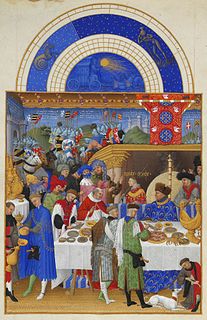
The Très Riches Heures du Duc de Berry or Très Riches Heures, is the most famous and possibly the best surviving example of manuscript illumination in the late phase of the International Gothic style. It is a book of hours: a collection of prayers to be said at the canonical hours. It was created between c. 1412 and 1416 for the extravagant royal bibliophile and patron John, Duke of Berry, by the Limbourg brothers. When the three painters and their sponsor died in 1416, possibly victims of plague, the manuscript was left unfinished. It was further embellished in the 1440s by an anonymous painter, who many art historians believe was Barthélemy d'Eyck. In 1485–1489, it was brought to its present state by the painter Jean Colombe on behalf of the Duke of Savoy. Acquired by the Duc d'Aumale in 1856, the book is now MS 65 in the Musée Condé, Chantilly, France.

A miniature is a small illustration used to decorate an ancient or medieval illuminated manuscript; the simple illustrations of the early codices having been miniated or delineated with that pigment. The generally small scale of such medieval pictures has led to etymological confusion with minuteness and to its application to small paintings, especially portrait miniatures, which did however grow from the same tradition and at least initially used similar techniques.
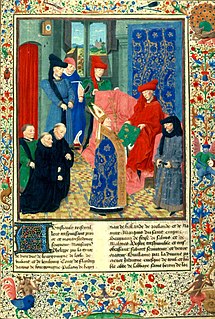
Simon Marmion was a French and Burgundian Early Netherlandish painter of panels and illuminated manuscripts. Marmion lived and worked in what is now France but for most of his lifetime was part of the Duchy of Burgundy in the Southern Netherlands.
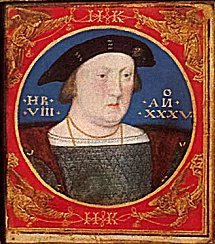
Lucas Horenbout, often called Hornebolte in England, was a Flemish artist who moved to England in the mid-1520s and worked there as "King's Painter" and court miniaturist to King Henry VIII from 1525 until his death. He was trained in the final phase of Netherlandish illuminated manuscript painting, in which his father Gerard was an important figure, and was the founding painter of the long and distinct English tradition of portrait miniature painting. He has been suggested as the Master of the Cast Shadow Workshop, who produced royal portraits on panel in the 1520s or 1530s.

Gerard Horenbout was a Flemish miniaturist, a late example of the miniature tradition in Early Netherlandish painting. He is "likely and widely accepted" to be the Master of James IV of Scotland.

The Master of James IV of Scotland was a Flemish manuscript illuminator and painter most likely based in Ghent, or perhaps Bruges. Circumstantial evidence, including several larger panel paintings, indicates that he may be identical with Gerard Horenbout. He was the leading illuminator of the penultimate generation of Flemish illuminators. The painter's name is derived from a portrait of James IV of Scotland which, together with one of his Queen Margaret Tudor, is in the Prayer book of James IV and Queen Margaret, a book of hours commissioned by James and now in Vienna. He has been called one of the finest illuminators active in Flanders around 1500, and contributed to many lavish and important books besides directing an active studio of his own.

The Rothschild Prayerbook or Rothschild Hours, is an important Flemish illuminated manuscript book of hours, compiled c. 1500–1520 by a number of artists.

The Isabella Breviary is a late 15th-century illuminated manuscript housed in the British Library, London. Queen Isabella I was given the manuscript shortly before 1497 by her ambassador Francisco de Rojas to commemorate the double marriage of her children and the children of Emperor Maximilian of Austria and Duchess Mary of Burgundy.
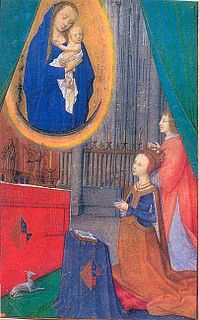
The Hours of James IV of Scotland, Prayer book of James IV and Queen Margaret is an illuminated book of hours, produced in 1503 or later, probably in Ghent. It marks a highpoint of the late 15th century Ghent-Bruges school of illumination and is now in the Austrian National Library in Vienna. It is thought to have been a wedding gift from James IV of Scotland or another Scottish nobleman to James's wife Margaret Tudor on the occasion of their marriage, perhaps finishing a book already started for another purpose. A number of artists worked on the extensive programme of decoration, so that "the manuscript in its entirety presents a rather odd picture of heterogeneity". The best known miniature, a full-page portrait of James at prayer before an altar with an altarpiece of Christ and an altar frontal with James's coat-of-arms, gave his name to the Master of James IV of Scotland, who is now generally identified as Gerard Horenbout, court painter to Margaret of Austria; he did only one other miniature in the book. The equivalent image of Margaret is the only image by another artist, using a rather generic face for the queen's portrait, and in a similar style to that of the Master of the First Prayer Book of Maximilian. Other artists worked on the other miniatures, which include an unusual series of unpopulated landscapes in the calendar – perhaps the Flemish artists were not sure how Scots should be dressed.

The Black Hours, MS M.493 is an illuminated book of hours completed in Bruges between 1460 and 1475. It consists of 121 pages (leaves), with Latin text written in Gothic minuscule script. The words are arranged in rows of fourteen lines and follow the Roman version of the texts. The lettering is inscribed in silver and gold and placed within borders ornamented with flowers, foliage and grotesques, on pages dyed a deep blueish black. It contains fourteen full-page miniatures and opens with the months of the liturgical calendar, followed by the Hours of the Virgin, and ends with the Office of the Dead.

The Hours of Mary of Burgundy is a book of hours, a form of devotional book for lay-people, completed in Flanders around 1477, and now in the National Library of Austria. It was probably commissioned for Mary, the ruler of the Burgundian Netherlands and then the wealthiest woman in Europe. No records survive as to its commission. The book contains 187 folios, each measuring 225 by 150 millimetres. It consists of the Roman Liturgy of the Hours, 24 calendar roundels, 20 full-page miniatures and 16 quarter-page format illustrations. Its production began c. 1470, and includes miniatures by several artists, of which the foremost was the unidentified but influential illuminator known as the Master of Mary of Burgundy, who provides the book with its most meticulously detailed illustrations and borders. Other miniatures, considered of an older tradition, were contributed by Simon Marmion, Willem Vrelant and Lieven van Lathem. The majority of the calligraphy is attributed to Nicolas Spierinc, with whom the Master collaborated on other works and who may also have provided a number of illustrations.
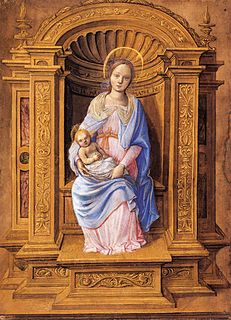
Jean Poyer, was a French miniature painter and manuscript illuminator of the late 15th century. As a multitalented artist - illuminator, painter, draftsman, and festival designer active from 1483 until his death - he was a painter of Renaissance France, working for the courts of three successive French kings: Louis XI, Charles VIII, and Louis XII.

The Hours of Philip the Bold is a late 14th-century illuminated book of hours produced in Paris for Philip the Bold, Duke of Burgundy (1363-1404). It contains illustrated calendars, figured initials and 11 large miniatures with ivy borders, following the Paris liturgy. The manuscript has a devotional use. Philip reportedly recited his daily prayers from this manuscript. His hours, which contains almost 200 images, is one of the most worldly manuscripts to survive from the library of the Burgundian Dukes. It is now MS. 3-1954 in the Fitzwilliam Museum, Cambridge.

The Taymouth Hours is an illuminated Book of Hours produced in England in about 1325–35. It is named after Taymouth Castle where it was kept after being acquired by an Earl of Breadalbane in the seventeenth or eighteenth century. The manuscript's shelf mark originates from its previous owner, Henry Yates Thompson, who owned an extensive collection of illuminated medieval manuscripts which he sold or donated posthumously to the British Library. The Taymouth Hours is now held by the British Library Department of Manuscripts in the Yates Thompson collection.
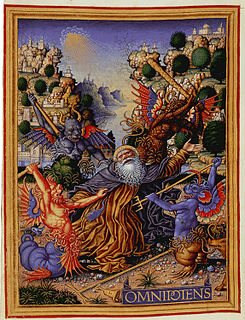
The Sforza Hours, is a richly illuminated book of hours initiated by Bona Sforza, widow of Galeazzo Sforza, Duke of Milan, around 1490, who commissioned the illuminator Giovanni Pietro Birago. The book remained in an unfinished state for 30 years until Margaret of Austria, Regent of the Netherlands, commissioned its completion in 1517–20 from the artist Gerard Horenbout. The book therefore contains decoration of the highest quality by two artists. It provides a unique example of an early sixteenth-century Northern Renaissance illuminator's response to Milanese art of the late Quattrocento. The history of the Sforza Hours also includes one of the earliest recorded examples of art theft.

The Gorleston Psalter is a 14th-century manuscript notable for containing early music instruction and for its humorous marginalia. It is named for the town of Gorleston in Norfolk.

The Hours of Joanna I of Castile is a sixteenth-century illuminated codex housed in the British Library, London, under call number Add MS 35313.
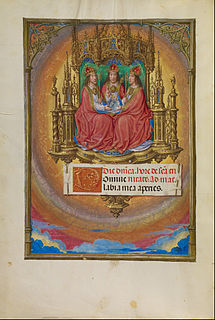
The Spinola Book of Hours is a sixteenth-century illuminated manuscript, consisting of 310 folios with 84 fully illustrated miniature paintings. This medieval manuscript was produced in the region between Bruges and Ghent in Flanders around 1510-1520. According to Thomas Kren, a former curator of the J. Paul Getty Museum, the artwork within the Spinola Hours can be attributed to five distinct artists. Forty-seven of these illuminated pages can be accredited to the 'Master of James IV'. The Spinola Hours bears a central coat-of-arms on the cover indicating it belonged to the Spinola family of Genoa. Today it is located at the J. Paul Getty Museum in Los Angeles.




















